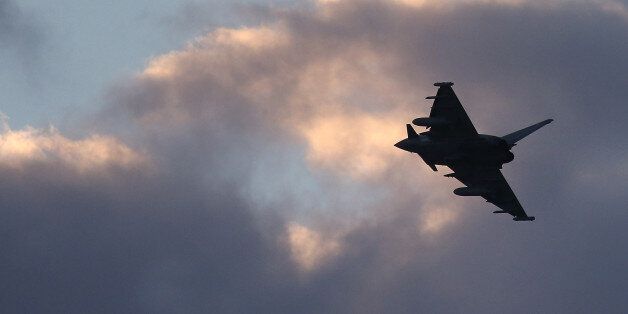
The RAF's celebrated Brimstone missile system has yet to kill or wound a single Isis terrorist in Syria since MPs controversially voted to support bombing raids in December.
A Freedom of Information (FOI) request by The Huffington Post UK also revealed just seven Isis militants have been killed or wounded by bombs dropped by RAF jets - either with Paveway bombs or Hellfire drone missiles.
Brimstone, hailed for its accuracy, was the main reason for the UK going into Syria, offering a military capability lacking among the US and French air forces, and was cited repeatedly by the Government and MPs.

Isis casualties broken down by location and missile type
The revelation has raised questions over Britain's involvement, the number of targets and costs. The Scottish National Party's Alex Salmond said the finding "contrasts dramatically" with David Cameron's argument Brimstone would "cut off the 'head of the snake'" in Isis's Raqqa HQ.
The Ministry of Defence (MoD), however, said the point of the air raids was not just to kill extremists, and pointed to the disruption they had caused to Isis infrastructure, including its lucrative oil fields.
Brimstone was used in nine raids between the vote and January 29, which is where the FOI data runs to. Often more than one bomb was dropped in a raid, taking out cranes, trucks and other Isis infrastructure.
All the strikes are detailed on the MoD website, but the department has until the FOI refused to specify how many militants have been killed. No civilian casualties have resulted from British attacks, it says.
Each Brimstone missile dropped is estimated to cost £100,000. Estimates vary, but Isis is thought to be able to muster as many as many as 32,000 fighters in Iraq and Syria.

The Brimstone missile, a rocket-propelled, radar-guided air-launched ground attack weapon
Cameron has hailed the accuracy of the Brimstone missiles for causing “the lowest level of civilian casualties” - heralding the plane’s high-definition camera that can “hover over the Isle of Wight and be able to read the hands on Big Ben”.
The SNP's MPs to a man and women opposed the raids. SNP MP Mr Salmond, the party's International Affairs spokesman in Westminster, told HuffPost UK: "This information contrasts dramatically with the case made by the Prime Minister for bombing when he said that the much-lauded Brimstone missile system would be crucial in cutting off the 'head of the snake' in Raqqa.
"It is now the common practice of this Prime Minister to mislead the country into military engagement and then to only devote a passing interest towards these crucial issues as his case crumbles before our eyes.
"I have little doubt that we shall soon be informed that it is back to Libya as the new crucial theatre of engagement as Cameron's attention span wanders elsewhere. Occasional spurts of interest do not represent a coherent policy against Daesh and bombing campaigns should not be used as a substitute for strategy."
A Ministry of Defence spokeswoman said: “We are playing a crucial role in a campaign that will take time and patience. Using the right weapon for each scenario, RAF jets have struck Daesh almost 600 times.
"In Iraq we have helped to drive them out of Sinjar and Ramadi. In Syria, we have severely weakened them by targeting their key infrastructure.”
The UK is part of a coalition with allies including the US and France, and the specifics of where strikes occur are decided to ensure "maximum coalition effectiveness".
The thinking behind targeting ISIS infrastructure, such as the Omar oil field, is to reduce its ability to raise finance to fund their terror campaign.
So far, oil revenue has been reduced by around 30% and their entire income has been cut by around 10%, the MoD says.
The MoD explained in the response to the FOI: "Since December 2015 UK military air activity has contributed to the Coalition’s aim of disrupting and degrading Daesh military infrastructure, logistics and revenue streams inside Syria.
"This includes targeting oil infrastructure and enabling equipment under Daesh control, helping to reduce their ability to profit from selling oil to fund their activities.
"We have also targeted Daesh’s military equipment and infrastructure, including vehicles, defensive fighting positions firing on friendly forces, a tunnel complex, weapons stores and a command and control centre.
"We estimate that 7 Daesh combatants have been killed or wounded as a result of RAF airstrikes in Syria between 2 December 2015 and 29 January 2016."
HuffPost UK has approached the Ministry of Defence for any further comment.

Some 397 MPs voted for the Government motion to expand bombing raids from Iraq and 223 against, a majority of 174
The House of Commons vote to back airstrikes in Syria - unlike in neighbouring Iraq a year earlier - proved controversial after Labour leader Jeremy Corbyn came out against the policy, causing a deep divide among the Opposition.
Though the vote passed comfortably, it was set against a backdrop of protests outside Westminster and later contributed to Corbyn's "revenge reshuffle", despite giving his Shadow Cabinet a free vote.
The RAF is using three aircraft to drop missiles: older Tornado jets which can carry Brimstone missiles and Paveway bombs; newer Typhoons that drop Paveway bombs but are not - as yet - capable of firing Brimstone missiles; and unmanned Reaper “drones” equipped with Hellfire missiles and bombs.
Brimstone missiles are estimated to cost £100,000 each, while heavier Paveway IV bombs are thought to cost £30,000 each. Hellfire missiles have a £71,300 price-tag each.